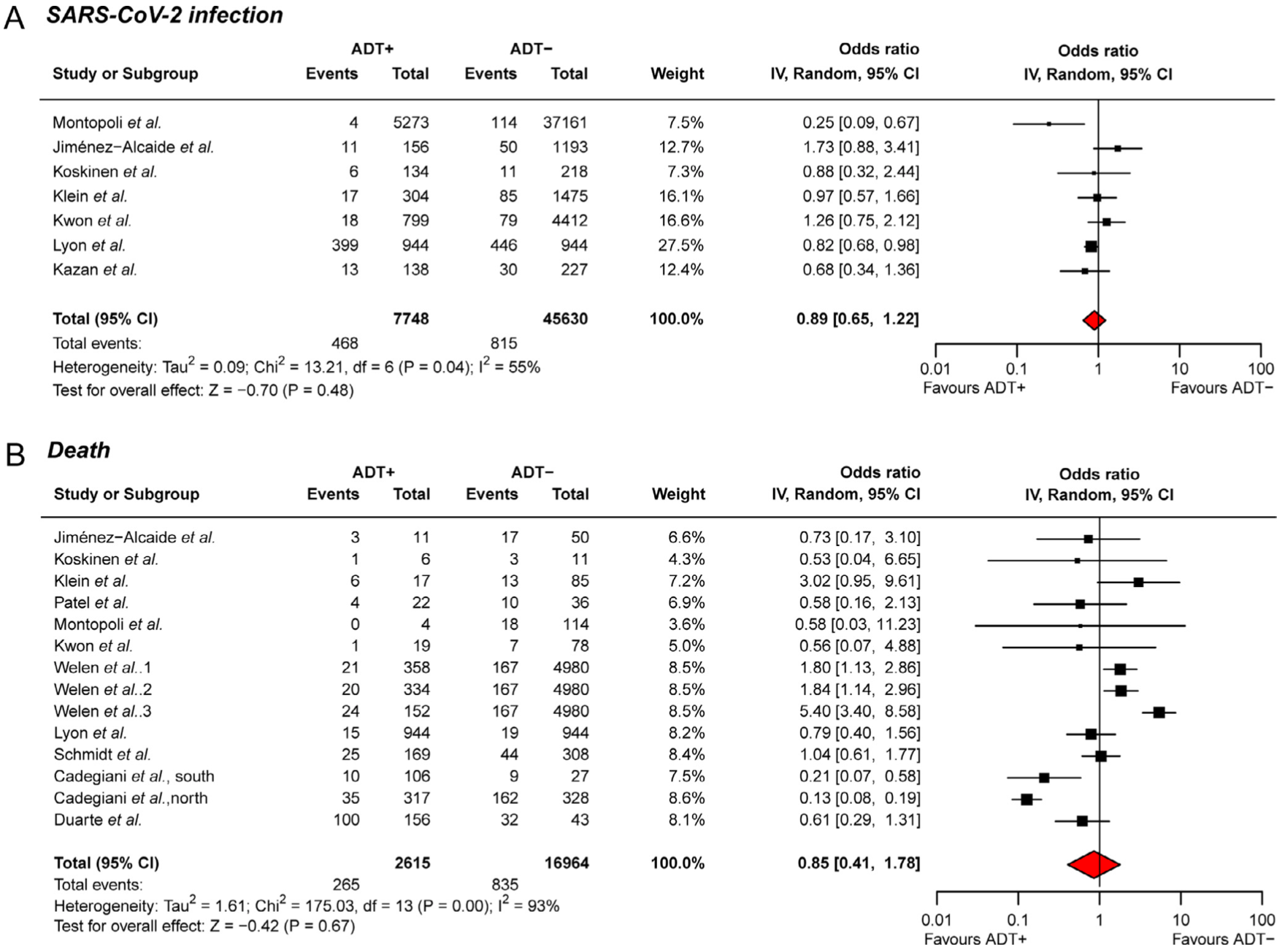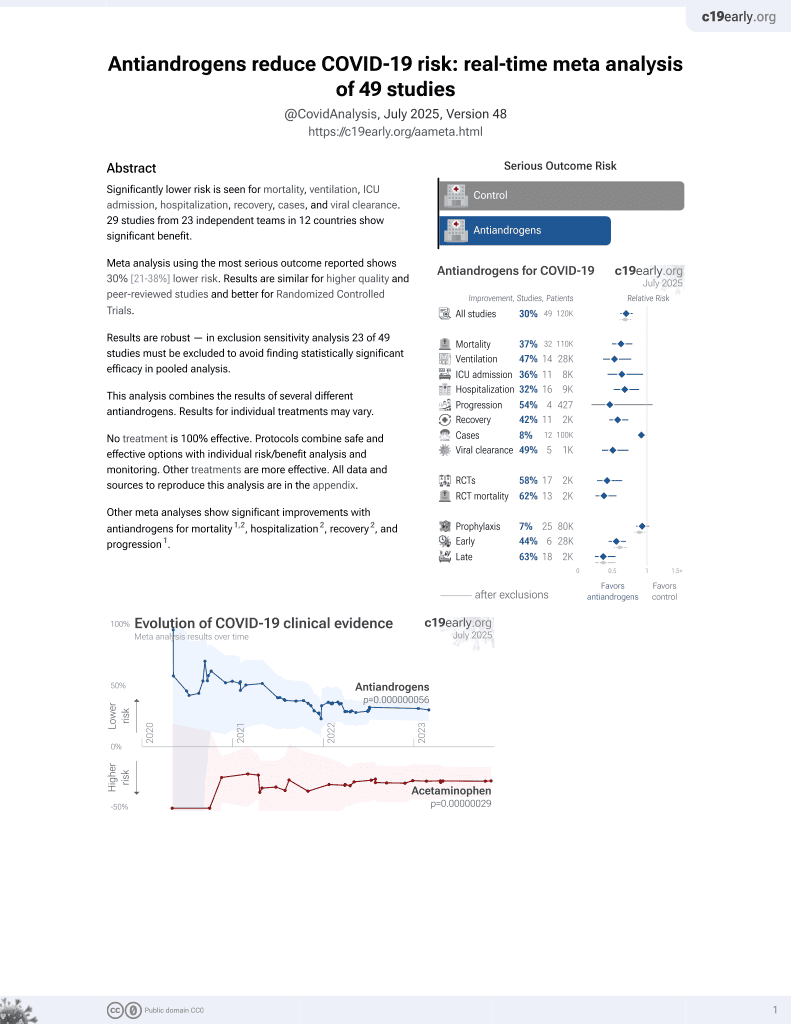
Protective trend of anti-androgen therapy during the COVID-19 pandemic: A meta-analysis
et al., Journal of Infection, doi:10.1016/j.jinf.2022.03.020, Mar 2022
7th treatment shown to reduce risk in
September 2020, now with p = 0.000000056 from 49 studies.
No treatment is 100% effective. Protocols
combine treatments.
6,300+ studies for
210+ treatments. c19early.org
|
Meta analysis of 15 antiandrogen studies showing a protective trend although there has been conflicting results to date.
2 meta analyses show significant improvements with antiandrogens for mortality1,2,
hospitalization2,
recovery2, and
progression1.
Currently there are 49 antiandrogens for COVID-19 studies, showing 37% lower mortality [21‑50%], 47% lower ventilation [23‑64%], 36% lower ICU admission [5‑57%], 32% lower hospitalization [11‑48%], and 8% fewer cases [1‑14%].
Meng et al., 31 Mar 2022, peer-reviewed, 11 authors.
Protective trend of anti-androgen therapy during the COVID-19 pandemic: A meta-analysis
Journal of Infection, doi:10.1016/j.jinf.2022.03.020
Protective trend of anti-androgen therapy during the COVID-19 pandemic: A meta-analysis Dear editor, Androgen receptor (AR) is an important transcription factor; thus, androgen and AR-associated pathways play pivotal roles in the progression of several diseases, including prostate cancer (PCa), benign prostatic hyperplasia (BPH), breast cancer, acne, and alopecia [ 1 , 2 ]. Anti-androgen therapy is widely used for the clinical treatment of prostatic diseases, including androgen deprivation therapy (ADT) via surgical castration, pharmacological castration,
Declaration of Competing Interest The authors have no conflicts of interest to declare.
Supplementary materials Supplementary material associated with this article can be found, in the online version, at doi:10.1016/j.jinf.2022.03.020 .
References
Deng, Rasool, Russell, Natesan, Asangani, Targeting androgen regulation of TMPRSS2 and ACE2 as a therapeutic strategy to combat COVID-19, iScience
Leach, Mohr, Giotis, Cil, Isac et al., The antiandrogen enzalutamide downregulates TMPRSS2 and reduces cellular entry of SARS-CoV-2 in human lung cells, Nat Commun
Lyon, Li, Cullen, Milinovich, Kattan et al., 5alpha-reductase inhibitors are associated with reduced risk of SARS-CoV-2 infection: a matchedpair, registry-based analysis, J Urol
Marks, Prasad, Souza, Burns, Senna, Topical antiandrogen therapies for androgenetic alopecia and acne vulgaris, Am J Clin Dermatol
Montopoli, Zumerle, Vettor, Rugge, Zorzi et al., Androgen-deprivation therapies for prostate cancer and risk of infection by SARS-CoV-2: a population-based study (N = 4532), Ann Oncol
Qiao, Wang, Mannan, Pitchiaya, Zhang et al., Targeting transcriptional regulation of SARS-CoV-2 entry factors ACE2 and TMPRSS2, Proc Natl Acad Sci
Shukla, Plaga, Shankar, Gupta, Androgen receptor-related diseases: what do we know?, Andrology
Welen, Rosendal, Gisslen, Lenman, Freyhult et al., A phase 2 trial of the effect of antiandrogen therapy on COVID-19 Outcome: No evidence of benefit, supported by epidemiology and in vitro data, Eur Urol
DOI record:
{
"DOI": "10.1016/j.jinf.2022.03.020",
"ISSN": [
"0163-4453"
],
"URL": "http://dx.doi.org/10.1016/j.jinf.2022.03.020",
"alternative-id": [
"S016344532200175X"
],
"author": [
{
"ORCID": "http://orcid.org/0000-0002-4622-833X",
"affiliation": [],
"authenticated-orcid": false,
"family": "Meng",
"given": "Jialin",
"sequence": "first"
},
{
"affiliation": [],
"family": "Ge",
"given": "Qintao",
"sequence": "additional"
},
{
"affiliation": [],
"family": "Li",
"given": "Jiawei",
"sequence": "additional"
},
{
"affiliation": [],
"family": "Lu",
"given": "Xiaofan",
"sequence": "additional"
},
{
"affiliation": [],
"family": "Chen",
"given": "Yonghao",
"sequence": "additional"
},
{
"affiliation": [],
"family": "Wang",
"given": "Haitao",
"sequence": "additional"
},
{
"affiliation": [],
"family": "Zhang",
"given": "Meng",
"sequence": "additional"
},
{
"affiliation": [],
"family": "Du",
"given": "Juan",
"sequence": "additional"
},
{
"affiliation": [],
"family": "Zhang",
"given": "Li",
"sequence": "additional"
},
{
"affiliation": [],
"family": "Hao",
"given": "Zongyao",
"sequence": "additional"
},
{
"affiliation": [],
"family": "Liang",
"given": "Chaozhao",
"sequence": "additional"
}
],
"container-title": [
"Journal of Infection"
],
"content-domain": {
"crossmark-restriction": false,
"domain": []
},
"created": {
"date-parts": [
[
2022,
3,
24
]
],
"date-time": "2022-03-24T23:24:56Z",
"timestamp": 1648164296000
},
"deposited": {
"date-parts": [
[
2022,
4,
2
]
],
"date-time": "2022-04-02T20:08:38Z",
"timestamp": 1648930118000
},
"funder": [
{
"DOI": "10.13039/501100001809",
"doi-asserted-by": "publisher",
"name": "National Natural Science Foundation of China"
}
],
"indexed": {
"date-parts": [
[
2022,
4,
4
]
],
"date-time": "2022-04-04T13:35:16Z",
"timestamp": 1649079316065
},
"is-referenced-by-count": 0,
"issn-type": [
{
"type": "print",
"value": "0163-4453"
}
],
"issued": {
"date-parts": [
[
2022,
3
]
]
},
"language": "en",
"license": [
{
"URL": "https://www.elsevier.com/tdm/userlicense/1.0/",
"content-version": "tdm",
"delay-in-days": 0,
"start": {
"date-parts": [
[
2022,
3,
1
]
],
"date-time": "2022-03-01T00:00:00Z",
"timestamp": 1646092800000
}
}
],
"link": [
{
"URL": "https://api.elsevier.com/content/article/PII:S016344532200175X?httpAccept=text/xml",
"content-type": "text/xml",
"content-version": "vor",
"intended-application": "text-mining"
},
{
"URL": "https://api.elsevier.com/content/article/PII:S016344532200175X?httpAccept=text/plain",
"content-type": "text/plain",
"content-version": "vor",
"intended-application": "text-mining"
}
],
"member": "78",
"original-title": [],
"prefix": "10.1016",
"published": {
"date-parts": [
[
2022,
3
]
]
},
"published-print": {
"date-parts": [
[
2022,
3
]
]
},
"publisher": "Elsevier BV",
"reference": [
{
"DOI": "10.1111/andr.12167",
"article-title": "Androgen receptor-related diseases: what do we know?",
"author": "Shukla",
"doi-asserted-by": "crossref",
"first-page": "366",
"issue": "3",
"journal-title": "Andrology",
"key": "10.1016/j.jinf.2022.03.020_bib0001",
"volume": "4",
"year": "2016"
},
{
"DOI": "10.1007/s40257-019-00493-z",
"article-title": "Topical antiandrogen therapies for androgenetic alopecia and acne vulgaris",
"author": "Marks",
"doi-asserted-by": "crossref",
"first-page": "245",
"issue": "2",
"journal-title": "Am J Clin Dermatol",
"key": "10.1016/j.jinf.2022.03.020_bib0002",
"volume": "21",
"year": "2020"
},
{
"DOI": "10.1016/j.annonc.2020.04.479",
"article-title": "Androgen-deprivation therapies for prostate cancer and risk of infection by SARS-CoV-2: a population-based study (N = 4532)",
"author": "Montopoli",
"doi-asserted-by": "crossref",
"first-page": "1040",
"issue": "8",
"journal-title": "Ann Oncol",
"key": "10.1016/j.jinf.2022.03.020_bib0003",
"volume": "31",
"year": "2020"
},
{
"DOI": "10.1097/JU.0000000000002180",
"article-title": "5alpha-reductase inhibitors are associated with reduced risk of SARS-CoV-2 infection: a matched-pair, registry-based analysis",
"author": "Lyon",
"doi-asserted-by": "crossref",
"first-page": "183",
"issue": "1",
"journal-title": "J Urol",
"key": "10.1016/j.jinf.2022.03.020_bib0004",
"volume": "207",
"year": "2022"
},
{
"article-title": "Targeting transcriptional regulation of SARS-CoV-2 entry factors ACE2 and TMPRSS2",
"author": "Qiao",
"journal-title": "Proc Natl Acad Sci U S A.",
"key": "10.1016/j.jinf.2022.03.020_bib0005",
"year": "2020"
},
{
"DOI": "10.1038/s41467-021-24342-y",
"article-title": "The antiandrogen enzalutamide downregulates TMPRSS2 and reduces cellular entry of SARS-CoV-2 in human lung cells",
"author": "Leach",
"doi-asserted-by": "crossref",
"first-page": "4068",
"issue": "1",
"journal-title": "Nat Commun",
"key": "10.1016/j.jinf.2022.03.020_bib0006",
"volume": "12",
"year": "2021"
},
{
"DOI": "10.1016/j.isci.2021.102254",
"article-title": "Targeting androgen regulation of TMPRSS2 and ACE2 as a therapeutic strategy to combat COVID-19",
"author": "Deng",
"doi-asserted-by": "crossref",
"issue": "3",
"journal-title": "iScience",
"key": "10.1016/j.jinf.2022.03.020_bib0007",
"volume": "24",
"year": "2021"
},
{
"DOI": "10.1016/j.eururo.2021.12.013",
"article-title": "A phase 2 trial of the effect of antiandrogen therapy on COVID-19 Outcome: No evidence of benefit, supported by epidemiology and in vitro data",
"author": "Welen",
"doi-asserted-by": "crossref",
"first-page": "285",
"issue": "3",
"journal-title": "Eur Urol",
"key": "10.1016/j.jinf.2022.03.020_bib0008",
"volume": "81",
"year": "2022"
}
],
"reference-count": 8,
"references-count": 8,
"relation": {},
"resource": {
"primary": {
"URL": "https://linkinghub.elsevier.com/retrieve/pii/S016344532200175X"
}
},
"score": 1,
"short-container-title": [
"Journal of Infection"
],
"short-title": [],
"source": "Crossref",
"subject": [
"Infectious Diseases",
"Microbiology (medical)"
],
"subtitle": [],
"title": [
"Protective trend of anti-androgen therapy during the COVID-19 pandemic: A meta-analysis"
],
"type": "journal-article"
}
